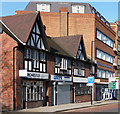1
Dorchester Parade, Leigham Court Road
Like the neighbouring Dorchester Court, designed by H.W. Binns, in 1936. This time, in mock-Tudor style with half-timbering and leaded windows. It is within the Streatham High Road and Streatham Hill Conservation Area.
Information from Lambeth Council (http://www.lambeth.gov.uk/NR/exeres/CE4B5CE1-0387-40ED-B5A9-273A5160C34A.htm ).
Image: © Stephen Richards
Taken: Unknown
0.02 miles
2
39, 43 and 45 Leigham Court Road
The semi-detached pair date from the 1860s, while the adjacent block is late C20th and purportedly echoes the scale and building line of the surrounding buildings. Hence, it is included in the Leigham Court Road (North) Conservation Area with the older pair.
Leigham Court Road was laid out in 1839, and while development began in the early 1840s, it didn’t really take off until after the building of the Crystal Palace and West End Railway and the opening of Streatham Hill station in 1856. Quite a number of the original, large Victorian houses survive at either end of the road, and even though their grounds have in some cases since been built on, the remaining mature trees and general landscaping have enabled the area to retain “much of its original arcadian character.” Information from Lambeth Council (http://www.lambeth.gov.uk/NR/exeres/CE4B5CE1-0387-40ED-B5A9-273A5160C34A.htm ).
Image: © Stephen Richards
Taken: Unknown
0.02 miles
3
South London Press, Leigham Court Road
An interesting brick building of the 1930s. It has strong horizontal emphases - the windows, including their glazing bars, and stringcourses - which contrast with the vertical emphasis imparted by the central staircase tower which bursts through the roof. It is within the Streatham High Road and Streatham Hill Conservation Area.
Information from Lambeth Council (http://www.lambeth.gov.uk/NR/exeres/CE4B5CE1-0387-40ED-B5A9-273A5160C34A.htm ).
Image: © Stephen Richards
Taken: Unknown
0.02 miles
4
Dorchester Court, Leigham Court Road
A residential scheme laid out and designed by H.W. Binns in 1935. A mixture of red brick, white rendering, green pantile roofs, together with full-height canted bays. It is within the Streatham High Road and Streatham Hill Conservation Area.
Information from Lambeth Council (http://www.lambeth.gov.uk/NR/exeres/CE4B5CE1-0387-40ED-B5A9-273A5160C34A.htm ).
Image: © Stephen Richards
Taken: Unknown
0.03 miles
5
47 Leigham Court Road
A four-storeyed house of yellow stock brick, probably built around the 1860s. Dormer windows break into the eaves which have very pronounced brackets. To the left can just be seen the original two-storey coach house, and a mature Holm Oak stands in the front garden. In 1868 it was occupied by John Wilkinson who owned Dining Rooms in Gracechurch Street. It is within the Leigham Court Road (North) Conservation Area.
Leigham Court Road was laid out in 1839, and while development began in the early 1840s, it didn’t really take off until after the building of the Crystal Palace and West End Railway and the opening of Streatham Hill station in 1856. Quite a number of the original, large Victorian houses survive at either end of the road, and even though their grounds have in some cases since been built on, the remaining mature trees and general landscaping have enabled the area to retain “much of its original arcadian character.” Information from Lambeth Council (http://www.lambeth.gov.uk/NR/exeres/CE4B5CE1-0387-40ED-B5A9-273A5160C34A.htm ).
Image: © Stephen Richards
Taken: Unknown
0.04 miles
6
Buildings at Streatham Hill
The block of buildings on the southwest side of Leigham Court Road as it approaches the Streatham High Road. The first brick building past the low gabled buildings is a recently-built (2007) medical group practice. Beyond is the HQ of the South London Press.
Image: © Derek Harper
Taken: 13 Jan 2011
0.05 miles
7
10 and 12 Leigham Court Road
A pair of semi-detached mid-Victorian houses built by George Trollope and Sons, who built extensively in the area at this time (including seventeen houses on this road). The ground floors are rusticated stucco while the floors above are of gault brick. There are a number of mature trees in front. Houses and grounds are within the Leigham Court Road (North) Conservation Area.
Leigham Court Road was laid out in 1839, and while development began in the early 1840s, it didn’t really take off until after the building of the Crystal Palace and West End Railway and the opening of Streatham Hill station in 1856. Quite a number of the original, large Victorian houses survive at either end of the road, and even though their grounds have in some cases since been built on, the remaining mature trees and general landscaping have enabled the area to retain “much of its original arcadian character.” Information from Lambeth Council (http://www.lambeth.gov.uk/NR/exeres/CE4B5CE1-0387-40ED-B5A9-273A5160C34A.htm ).
Image: © Stephen Richards
Taken: Unknown
0.05 miles
8
49 Leigham Court Road
One of the most striking buildings in Streatham, with its central projecting bay topped by an octagonal roof making it the closest the area gets to the Scottish Baronial style. Dating from the 1860s it was originally known as St Margaret, and from 1896 to 1924 was the home of William Raymond Axtens, partner in the then well-known Brixton department store Quin and Axtens. It has been the home of Streatham Constitutional Club since 1929, and is within the Leigham Court Road (North) Conservation Area.
Leigham Court Road was laid out in 1839, and while development began in the early 1840s, it didn’t really take off until after the building of the Crystal Palace and West End Railway and the opening of Streatham Hill station in 1856. Quite a number of the original, large Victorian houses survive at either end of the road, and even though their grounds have in some cases since been built on, the remaining mature trees and general landscaping have enabled the area to retain “much of its original arcadian character.” Information from Lambeth Council (http://www.lambeth.gov.uk/NR/exeres/CE4B5CE1-0387-40ED-B5A9-273A5160C34A.htm ).
Image: © Stephen Richards
Taken: Unknown
0.05 miles
9
Streatham Constitutional Club
This building with a distinctive facade accommodates groups such as the Rotary Club.
Image: © Bill Boaden
Taken: 1 Feb 2014
0.06 miles
10
Leigham Court Road, Streatham
Image: © David Howard
Taken: 5 Apr 2015
0.06 miles











